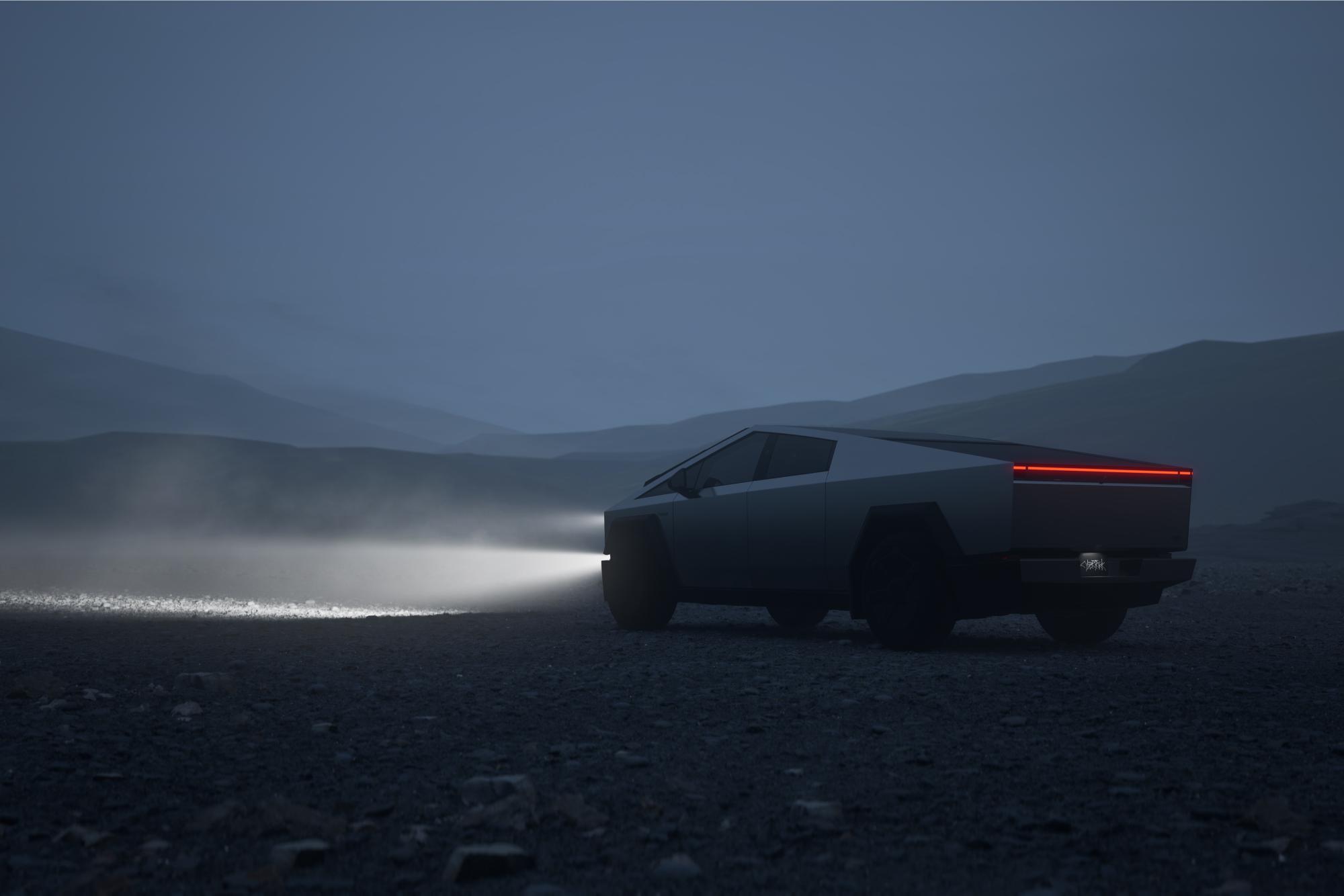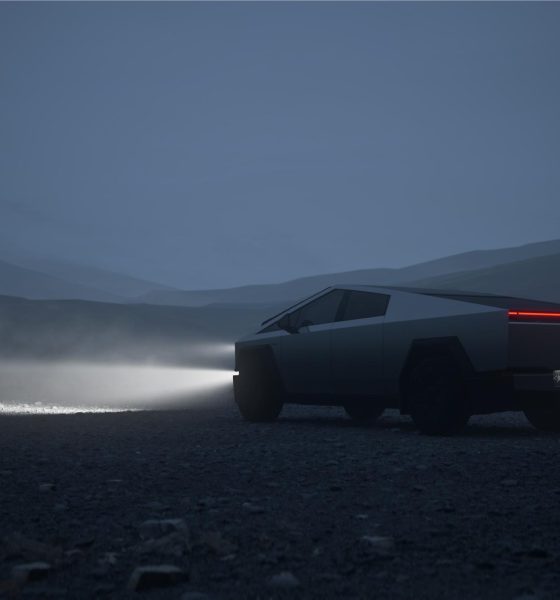

News
Tesla Cybertruck accelerator pedal issue listed as NHTSA recall for unintended acceleration
The Tesla Cybertruck’s acceleration pedal issue, which caused a temporary halt in the customer deliveries of the all-electric pickup truck, has been listed as a recall by the National Highway Traffic Safety Administration (NHTSA). As per the NHTSA’s official website, the recall was initiated to address risks for unintended acceleration from a trapped accelerator pedal on affected vehicles.
The NHTSA’s Safety Recall Report revealed that a total of 3,878 units of the 2024 Tesla Cybertruck are affected by the accelerator pedal issue. Affected vehicles were produced from November 13, 2023 to April 4, 2024. Similar to observations from Tesla Cybertruck owners, the NHTSA Safety Recall Report noted that the accelerator pedal might get dislodged and trapped in the interior trim when high force is applied to the pad.
The Tesla Cybertruck’s accelerator pedal issue is described as follows in the NHTSA Safety Recall Report:
“If the pad on the accelerator pedal becomes trapped in the interior trim above the pedal, the performance and operation of the pedal will be affected, which may increase the risk of a collision. Note that application of the brake pedal will cut drive torque, including when both brake and accelerator pedals are pressed, and continued application of the brake pedal will bring the vehicle to a stop as quickly as if the accelerator pedal was not pressed,” the report read.
Aș per the NHTSA’s report, the cause of the Cybertruck’s accelerator pedal issue was an unapproved change that introduced a lubricant, soap, to aid in the component assembly of the pad onto the accelerator pedal. Residual lubricant ended up reducing the retention of the pad to the pedal.
The Safety Recall Report’s chronology section showed Tesla’s quick response to the issue. As per the document, Tesla was initially made aware of the accelerator pedal issue on March 31, 2024, through a customer claim. On April 2, Tesla Engineering reviewed the vehicle’s data logs, which confirmed that the driver did press the brakes and accelerator at the same time to bring the affected Cybertruck to a stop.
Another customer claim was received by Tesla on April 3, and through the week of April 8, Tesla Engineering conducted additional tests to determine the scope and behavior of the issue. A decision to recall the affected Cybertrucks was made on April 12, 2024. No crashes or accidents are believed to have been caused by the issue as of April 15, 2024.
There were no injuries or accidents because of this. We are just being very cautious.— Elon Musk (@elonmusk) April 18, 2024
Unlike most Tesla recalls, the Cybertruck’s accelerator pedal issue is hardware related. Thus, it would not be fixed through an over-the-air software update. To address the issue, Tesla will be replacing the faulty accelerator pedal assembly in affected Cybertrucks with a setup that meets specifications. All Cybertrucks produced from April 17, 2024 are already equipped with a new accelerator pedal component, and units that are at delivery centers or in transit will receive the remedy prior to their customer handovers.
Recent posts on social media and Elon Musk’s comments have suggested that Cybertruck deliveries have resumed. As per Musk, the temporary halt in Cybertruck deliveries was also done over an abundance of caution. “There were no injuries or accidents because of this. We are just being very cautious,” Musk wrote in a post on X.
The NHTSA’s Safety Recall Report on the Cybertruck’s accelerator pedal issue can be viewed below.
RCLRPT-24V276-7026 by Simon Alvarez on Scribd
Don’t hesitate to contact us with news tips. Just send a message to simon@teslarati.com to give us a heads up.

Elon Musk
Starlink passes 9 million active customers just weeks after hitting 8 million
The milestone highlights the accelerating growth of Starlink, which has now been adding over 20,000 new users per day.

SpaceX’s Starlink satellite internet service has continued its rapid global expansion, surpassing 9 million active customers just weeks after crossing the 8 million mark.
The milestone highlights the accelerating growth of Starlink, which has now been adding over 20,000 new users per day.
9 million customers
In a post on X, SpaceX stated that Starlink now serves over 9 million active users across 155 countries, territories, and markets. The company reached 8 million customers in early November, meaning it added roughly 1 million subscribers in under seven weeks, or about 21,275 new users on average per day.
“Starlink is connecting more than 9M active customers with high-speed internet across 155 countries, territories, and many other markets,” Starlink wrote in a post on its official X account. SpaceX President Gwynne Shotwell also celebrated the milestone on X. “A huge thank you to all of our customers and congrats to the Starlink team for such an incredible product,” she wrote.
That growth rate reflects both rising demand for broadband in underserved regions and Starlink’s expanding satellite constellation, which now includes more than 9,000 low-Earth-orbit satellites designed to deliver high-speed, low-latency internet worldwide.
Starlink’s momentum
Starlink’s momentum has been building up. SpaceX reported 4.6 million Starlink customers in December 2024, followed by 7 million by August 2025, and 8 million customers in November. Independent data also suggests Starlink usage is rising sharply, with Cloudflare reporting that global web traffic from Starlink users more than doubled in 2025, as noted in an Insider report.
Starlink’s momentum is increasingly tied to SpaceX’s broader financial outlook. Elon Musk has said the satellite network is “by far” the company’s largest revenue driver, and reports suggest SpaceX may be positioning itself for an initial public offering as soon as next year, with valuations estimated as high as $1.5 trillion. Musk has also suggested in the past that Starlink could have its own IPO in the future.
News
NVIDIA Director of Robotics: Tesla FSD v14 is the first AI to pass the “Physical Turing Test”
After testing FSD v14, Fan stated that his experience with FSD felt magical at first, but it soon started to feel like a routine.

NVIDIA Director of Robotics Jim Fan has praised Tesla’s Full Self-Driving (Supervised) v14 as the first AI to pass what he described as a “Physical Turing Test.”
After testing FSD v14, Fan stated that his experience with FSD felt magical at first, but it soon started to feel like a routine. And just like smartphones today, removing it now would “actively hurt.”
Jim Fan’s hands-on FSD v14 impressions
Fan, a leading researcher in embodied AI who is currently solving Physical AI at NVIDIA and spearheading the company’s Project GR00T initiative, noted that he actually was late to the Tesla game. He was, however, one of the first to try out FSD v14.
“I was very late to own a Tesla but among the earliest to try out FSD v14. It’s perhaps the first time I experience an AI that passes the Physical Turing Test: after a long day at work, you press a button, lay back, and couldn’t tell if a neural net or a human drove you home,” Fan wrote in a post on X.
Fan added: “Despite knowing exactly how robot learning works, I still find it magical watching the steering wheel turn by itself. First it feels surreal, next it becomes routine. Then, like the smartphone, taking it away actively hurts. This is how humanity gets rewired and glued to god-like technologies.”
The Physical Turing Test
The original Turing Test was conceived by Alan Turing in 1950, and it was aimed at determining if a machine could exhibit behavior that is equivalent to or indistinguishable from a human. By focusing on text-based conversations, the original Turing Test set a high bar for natural language processing and machine learning.
This test has been passed by today’s large language models. However, the capability to converse in a humanlike manner is a completely different challenge from performing real-world problem-solving or physical interactions. Thus, Fan introduced the Physical Turing Test, which challenges AI systems to demonstrate intelligence through physical actions.
Based on Fan’s comments, Tesla has demonstrated these intelligent physical actions with FSD v14. Elon Musk agreed with the NVIDIA executive, stating in a post on X that with FSD v14, “you can sense the sentience maturing.” Musk also praised Tesla AI, calling it the best “real-world AI” today.
News
Tesla AI team burns the Christmas midnight oil by releasing FSD v14.2.2.1
The update was released just a day after FSD v14.2.2 started rolling out to customers.

Tesla is burning the midnight oil this Christmas, with the Tesla AI team quietly rolling out Full Self-Driving (Supervised) v14.2.2.1 just a day after FSD v14.2.2 started rolling out to customers.
Tesla owner shares insights on FSD v14.2.2.1
Longtime Tesla owner and FSD tester @BLKMDL3 shared some insights following several drives with FSD v14.2.2.1 in rainy Los Angeles conditions with standing water and faded lane lines. He reported zero steering hesitation or stutter, confident lane changes, and maneuvers executed with precision that evoked the performance of Tesla’s driverless Robotaxis in Austin.
Parking performance impressed, with most spots nailed perfectly, including tight, sharp turns, in single attempts without shaky steering. One minor offset happened only due to another vehicle that was parked over the line, which FSD accommodated by a few extra inches. In rain that typically erases road markings, FSD visualized lanes and turn lines better than humans, positioning itself flawlessly when entering new streets as well.
“Took it up a dark, wet, and twisty canyon road up and down the hill tonight and it went very well as to be expected. Stayed centered in the lane, kept speed well and gives a confidence inspiring steering feel where it handles these curvy roads better than the majority of human drivers,” the Tesla owner wrote in a post on X.
Tesla’s FSD v14.2.2 update
Just a day before FSD v14.2.2.1’s release, Tesla rolled out FSD v14.2.2, which was focused on smoother real-world performance, better obstacle awareness, and precise end-of-trip routing. According to the update’s release notes, FSD v14.2.2 upgrades the vision encoder neural network with higher resolution features, enhancing detection of emergency vehicles, road obstacles, and human gestures.
New Arrival Options also allowed users to select preferred drop-off styles, such as Parking Lot, Street, Driveway, Parking Garage, or Curbside, with the navigation pin automatically adjusting to the ideal spot. Other refinements include pulling over for emergency vehicles, real-time vision-based detours for blocked roads, improved gate and debris handling, and Speed Profiles for customized driving styles.








